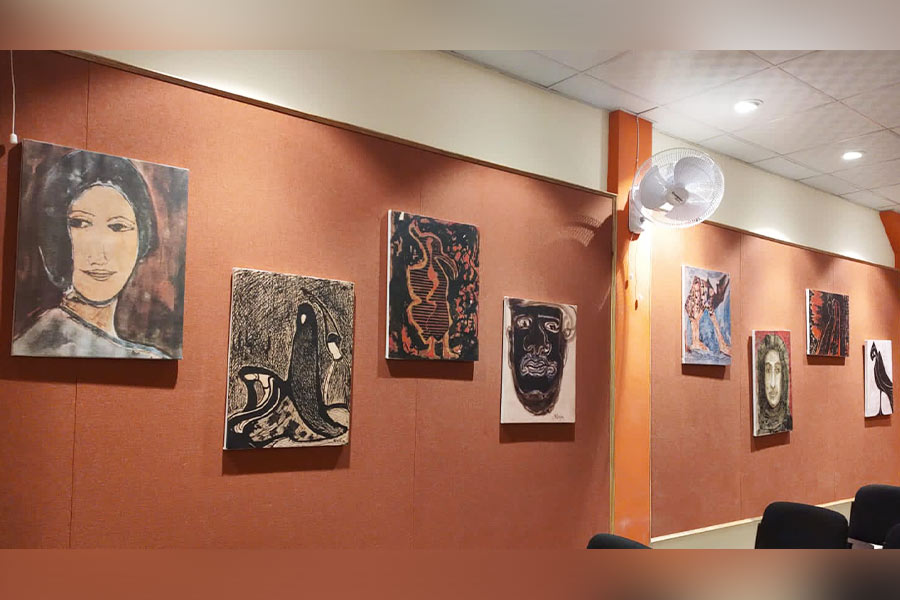The third edition of Learn Togetherness, a Kolkata Centre for Creativity event curated by interdisciplinary artist Sujoy Prasad Chatterjee, is drawing Calcuttans from far and wide, capturing hearts and minds. The 11-day event that goes by the theme “What is in our gait? The Performative and Queer” recently screened Chatterjee’s directorial debut Home, a silent short film based on Arundhathi Subramaniam’s poem Home.
Produced by Paromita Lahiri Banerjee, Deepak Bajaj, Preetam Mukherjee and Aritra Sen and with Modhura Palit as DOP, the silent film, shot in a sepia tone, features Sudipa Basu, Bidipta Chakraborty, Chandreyee Ghosh, Aparajita Auddy, Sohini Sarkar, Tuhina Das, Suparna Datta, Subhasree Patel, Ratasree Dutta, Debjani Chatterjee, Paramita Saha and Sauraseni Maitra.
After the screening, actor Joy Sengupta and Sujoy sat down and immersed the audience in a free-wheeling conversation as the latter went on to make quite a few interesting revelations about how the film was born.
Chatterjee’s film rests on minimal props and maximum intellect. The different characters and their struggles of finding “home” make viewers constantly root for them. Chatterjee, who is in the director’s chair for this emotionally stimulating film, tells viewers how the safe place for every living object — “home” — can be interpreted in the context of the film. Expressing their gratitude to Sengupta for his “friendship and mentorship” that has led to Chatterjee’s film coming into fruition, they explained: “ We were playing with the word ‘home’ at a friend’s house with a few of my students of interdisciplinary arts. That was before Covid. We were sitting together and having coffee and this came up: ‘What does home mean to all of you?’ This has been lying with me for many years.. I read this poem of Subramaniam for the first time in one of the oldest queer book stores, Glad Day, in Toronto. My sister introduced me to Subramaniam’s poetry, and I stuck with this one. This has been in me somewhere. Somebody said home means gender while another said home means cuisine (food). I was haunted by a lot of images. These images (as shown in the film) came to me. If I had incorporated all the images, it would have been a longer film. When we were discussing these images in his office, Sunny Ray (chief associate director) said: ‘I don’t want words; I want silence and I will deconstruct this poem in my own way.’ It was not easy for me to deconstruct Subramaninam’s poem because the form is different and the images are very disconnected from one another. Sunny sat with the editor and I was insistent that the film be made in black and white because I love black and white. It’s not about the spectrum. It’s who I am. After watching the film, Arundhathi said: “I thought the film began where the poem ended. It was like an extension of the poem.... it was travelling all around me; it was countering my whole system when I saw the film.”
Answering a question on why they chose to make a silent film, Sujoy said: “Silence is the dialogue for me. What I had seen happening to me.... Covid helped me to see through people; it helped me to grow as an artist…. my artistic vision was shaped a lot during the pandemic. That trigger was there. Arundhathi’s work itself was the biggest trigger for me — it is possibly the cacophony she talks about in her poem, that is the real silence for me, and that cacophony is strewn around the film.”
Joy pointed out, how the deeply personal visuals in the film are representative of each rasa and that there was a lot of use of mirrors in the film, which Joy aptly described as “ portraying emotions and emotions are universal” and “gentler sublime emotion is queer”. Sujoy, reiterated that they are not from a film school background; they emphasized how they had treated each story shown in the film with a sensible use of metaphors.
Actor Ratasree Dutta said: “The character that I have played in the film, it’s about her relationship with the other woman we see in the film and how she misses it in the present day.”






